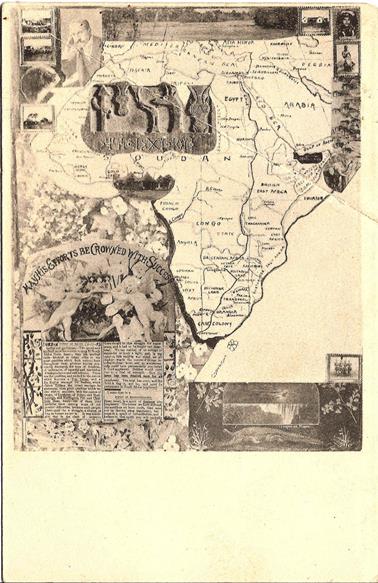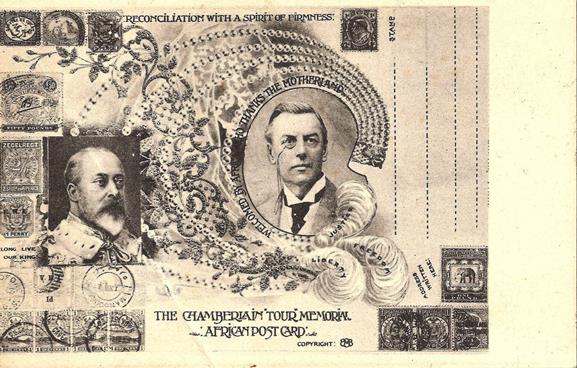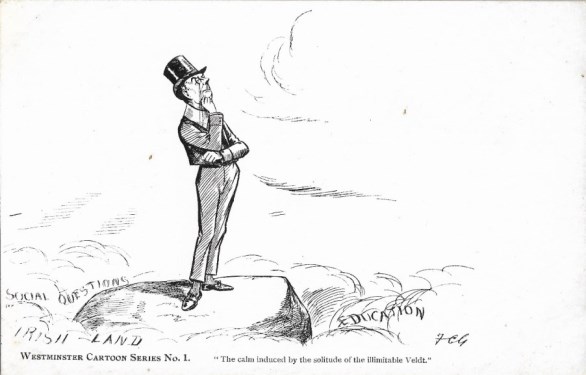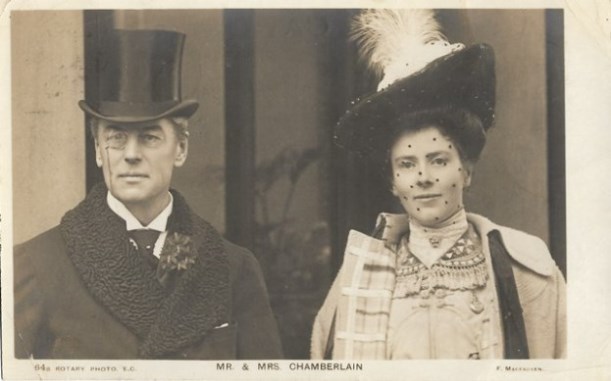
Jeff Woolgar
JOSEPH CHAMBERLAIN SOUTH AFRICAN TOUR
PITIABLE POSTCARD DESIGN ?
Introduction.
Edith Lyttelton records:
‘Early in November 1902 Mr. Chamberlain [Colonial Secretary] invited Alfred [Lyttelton, British colonial administrator] and me to
luncheon with him and his wife [Mary, née Endicott] at the Carlton Restaurant, [London],
and there told us of his decision to go to South Africa. This was the first time a Minister of the Crown had visited a Colony in his official capacity. …
He was full of interest and enthusiasm over his journey as [if he were] a young man of twenty going for his first foreign trip.’
The African Tour
He sailed with his wife on the 25th November from Portsmouth, on the maiden voyage of the cruiser H.M.S. Good Hope. The ship called in at
Egypt and East Africa – Mombasa.
They arrived at Durban, Natal, on the 26th of December 1902. From Durban he travelled by train to
Pietermaritzburg, Colenso, and Ladysmith, seeing the battlefields and on to Charlestown.
Here he was met by Lord Alfred Milner and possibly talked about the
amalgamation of the Transvaal and Orange River Colony railways which took place the following year.
At Chieveley they stood for a moment by the grave of Lord Roberts’ Son,
who died during the recent South African War. From Charlestown he crossed the new border to Volksrust in the Transvaal Colony. Continuing by train he visited several towns,
including Pretoria, Johannesburg and Potchefstroom. Describing Potchefstroom to her Mother, Mary Chamberlain, said it was “a quiet little town with a sort
of village green in the centre, surrounded by Oak Trees”. Here Joseph Chamberlain
Reviewed the Garrison, Potchefstroom Cantonment, - see postcard messages. From here he travelled by waggon to Ottoshoop and on to Mafeking,
where he took the train south via Vryburg and Kimberley.
He continued from Kimberley by waggon to Bloemfontein in the Orange River Colony (Free State). He then visited the key towns in Cape Colony by train,
and gave his last speech at the Drill Hall in Cape Town. He and his party boarded the Steam Ship Norman on the 25th of February 1903,
bound for the British Isles.
For two months, Joseph Chamberlain and his party endured long waggon treks across the silent veld, and train journeys over the Great Karroo.
He visited 29 towns, delivered 64 speeches, received 87 deputations, and gave 250 interviews.
The Picture Postcard
The message side above and the address side below.


In celebrating Joseph Chamberlain’s tour of South Africa, I muse as to whether the design of the postcard was put together by a committee! The chaotic montage of pictures, maps, and postage & revenue stamps, from the countries he visited, and one he didn’t, plus the Tati Concessions Ltd. stamp, could barely have encouraged the next generation of graphic designers. Basically, it is a mêlée of untidy leftovers.
The map of Africa shows the impossible dream of the Cape to Cairo Railway. Did anybody think it possible to maintain, man, finance and operate a railway of over 5,000 miles, through difficult and changing terrane? Given the problems of raising the required capital for new narrow-gauge railway construction and equipment, in southern Africa over the previous 25 years, and the failure to establish a zollverein or customs union, only a fool would have invested in a railway from Cape Colony to Egypt.*
Look at the postcard and you will find such words as ‘Liberty’, ‘Freedom' and ‘Justice’. Joseph Chamberlain’s tour was one of reconciliation between Boer and Britain, which he followed through to the end of his tour. However, one of the messages on the postcard here reads, ‘Reconciliation with a Spirit of Firmness’.
* Following the battle of Omdurman (2nd September 1898) and the reconquest of the Sudan, Chamberlain told a reporter in New York, ‘Young man, you will live to see the time when a railroad will be built through that country to the Great Lakes, the Transvaal and the Cape’.


Leaving Cape Colony on the night of 25th February 1903, aboard the S.S. Norman he was feeling good. However, when he reached Madeira, he was bitterly disappointed to learn that the Chancellor of the Exchequer C.T. Ritchie, was considering abolishing tax on the importation of corn, as this could have a profound effect on his idea of drawback of tax in respect of British and Colonial goods. He disembarked at Southampton on 14th March 1903 very tired from his tour and clearly aware of his political problems.
This was to be his last year as part of Balfour’s Cabinet, he was expected to resign following the budget on 23rd April, when the duty on corn was discarded, which meant that the basis for Imperial Preference for which he had campaigned was dead. However, he optimistically endeavoured to win over his Cabinet colleagues and the Prime Minister during the summer. Unable to do so, he resigned from the Cabinet (and as Secretary of State for the Colonies) on 16th September 1903.
Chamberlain’s political thinking changed over the years and he never sought premiership. Although worshiped in his adopted City of Birmingham, he was later blamed by many for the Second Anglo-Boer War. Always concerned about the rise of German influence and control in Southern Africa he lingered on in Parliament, a sick man, unable to hold a pen, and died on 2nd July 1914, the day the London newspapers reported the assassination in Sarajevo of Archduke Francis Ferdinand on the 28th June.
Bibliography
Lyttelton, Edith Sophy, (1923) Alfred Lyttelton an Account of his Life [abridged], Longmans, Green and Co.
Amery, J., (1951), The Life of Joseph Chamberlain, volume four 1901-1903, At the height of his power, Macmillan and Co, Ltd. London.
Amery, J., (1969), Joseph Chamberlain and the Tariff Reform Campaign, The Life of Joseph Chamberlain, volume five, Macmillan and Co, Ltd. London.
Garvin, J.L., (1934), The Life of Joseph Chamberlain, volume three 1895-1900, Empire and World Policy, Macmillan and Co, Ltd. London.
- - 'Back to Postcards. - -
Copyright © J Woolgar 2020 & 2021